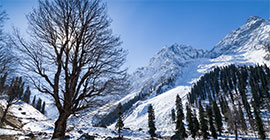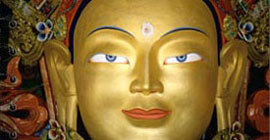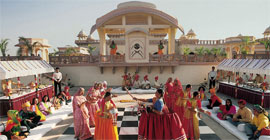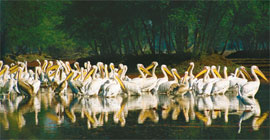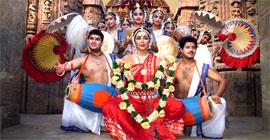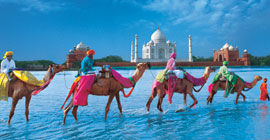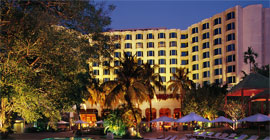JALANDHAR
Home | Jalandhar
Jalandhar is located almost 375 km from Delhi, 150 km from Chandigarh and about 80 km from Amritsar. Jalandhar is named after Jalandhara, a demon king who lived in water as his name suggests Jal (water) and andhar (in). It was the capital of Punjab until 1953, when it was replaced by Chandigarh.
Jalandhar was a hub of green revolution of India in early 60s. Dr. Dilbag Singh Athwal, world renowned scientist in plant breeding, developed India's first high yield wheat KALYAN. The wheat he name afer his native village Kalyanpur 6 miles southwest of city of Jalandhar. Later Dr. Athwal headed International Rice Research Institute, International Agricultural Development Service etc. Dr. Athwal took early retirement from his position as senior vice president Rockefeller Institute. The village Kalyanpur (now part of Jalandhar city) have produced prominent scientist including Dr. Raghbir Singh, Dr. Rajbir Kaur, Dr. Iqbal Singh Athwal.
Jalandhar is also famous for its surgical tool industry. Jalandhar produces a large number of surgical tools. Big companies like Camlin outsource their production here. The city boasts of having the largest number of in Asia. A place called Basti Sheikh has many cottage projects which run without any help of the Punjab government.
Jalandhar also has the biggest printing industry in India. Major publishing and advertising companies like, MBD, Aay Bee advertisers have their main offices in Jalandhar.
Jalandhar is seeing an increasing growth of technology investment, with headquarters and operational centres from the likes of Dell and Microsoft being set up. Jalandhar is also the home of the headquarters of Kayako.
Jalandhar Cantonment
Vajra Go Karting which is open to civilians also, is a big attraction Cantonment is dotted with buildings dating back to British era.
Jalandhar Cantonment is one of the oldest cantonments in India, the construction of which was started in 1848 after the first Anglo-Sikh War, when the British settled in Northern India. The original scope of this cantonment was limited to troops to quell disturbances from adjoining States for the maintenance of peace and order. In 1920 the cantonment was the scene of mutiny by Irish soldiers, who took down the Union Flag and replaced it by the flag of the Irish Republic, proclaimed at the time in Dublin (See The Connaught Rangers#Mutiny in India, 1920).
The departure of British from India and subsequent partition of the country changed the complexion of the Cantonment. It has gained tremendous importance on account of its nearness to the border with Pakistan. The Cantonment is located between latitude 30° 18' and longitude 75° 37' on the southwest and at a distance of 2 km from Cantonment Railway Station and 5 km from City Railway Station. It is situated beside Grand Trunk Road at a distance of 89 km from Amritsar and 371 km from Delhi. It covers an area of 5.87 square miles (15.2 km²). It is on Amritsar-Delhi Broad Gauge Main Line. A Class-I airfield at Adampur is situated at a distance of 19 km. The airfield is linked with Jalandhar Cantonment by rail and road. The cantonment is also home to the classic lovely sweet house which offers more than two hundred varieties of classic traditional indian sweets.
Travel options from Delhi include train and road travel. Jalandhar is well connected by trains, including a Shatabdi train from Delhi to Amritsar via Jalandhar which runs twice a day with air-conditioned chair car coaches. Jammu Mail, among others, runs in the night from Delhi to Jalandhar.
Places to visit in Jalandhar:Amongst the various places to visit in Jalandhar a few are The Pushpa Gujral Science City, The Devi Talab Mandir, Haveli (a restaurant that gives you the feel of the village life in Punjab),Wonderland, etc.
Harballabh Fair
The most notable event in Jalandhar is the annual national Harballabh Fair which is held every year from 26th to 29 December. Prominent exponents of classical music, both vocal and instrumental, from all over the country gathers to provide a rare feast of music for the connoisseur. The Sangeet Sammelan is held in the premises of Devi Talab 1.5 km from the Railway Station. Even Mahatma Gandhi was attracted to the festival in 1929. Jalandhar has been in the thick of the fight for freedom from the British Raj and has produced many patriots. A Desh-Bhagat Memorial Hall has been constructed here to perpetuate the memory of such martyrs. More information on Harballabh is available at their official
Devi Talab Mandir
An old temple of goddess Kali stands by the side of the Devi Talab. It is one of the 51 Shakti Peethas and the Kali is known as Tripurmalini. Sati Devi's right breast fell here. Lord Shiva of this temple is called Bhishan Bhairav.
Maa Chinmastika welfare Society
Maa Chinmastika Welfare Society is the known welfare society and office situated at Quilla Mohalla Jalandhar. It has organized many religious and social function in Jalandhar. The office of the society is situated at Quilla Mohalla Jalandhar.
Baba Sodal Mela
The fair of Baba Sodal is associated with Sodal, a small boy who came to be respected as a baby-God. The fair is held to commemorate his death anniversary at his smadhi. The fair is held once a year in the month of Bhadon, which roughly corresponds to mid-September. The celebration takes place on the 14th of Shukal Paksh (bright half of the lunar month), the day on which the child deity left for his heavenly abode. The fair lasts for one day. In the early hours of the morning, women come in large numbers to make offerings at the samadhi.
The legend goes that Sodal was born in a family of Chadha clan of Khatri caste in Jalandhar City. It is said that one day the mother of Baba Sodal went to nearby pond to wash clothes. Despite her repeatedly asking to him to go back, he followed her. The mother lost her temper and shouted at him, "Have you come here to die Go and drown yourself in the pond." It is said that Sodal asked her three times to repeat her words, which she did. Sodal then plunged into the water, never to appear again. According to another version, he simply fell dead on the spot; according to still another, he transformed himself into a snake and bored himself into the earth.
The main place of worship is the samadhi of Baba Sodal. Inside the samadhi, there is a painted portrait of Baba Sodal kept decorated with garlands and rosaries and is looked after by a separate priest. There is a pucca tank called ‘Baba Sodal-Da-Sarowar’. The offering at the samadhi are distributed among the pilgrims, who sprinkle a few drops on their bodies. Some have a dip in the tank.
Pilgrims of all religions come to the fair from different parts of Punjab, Haryana, Delhi and Uttar Pradesh. Among the pilgrims, females form the majority, to seek blessing for children and general well-being of their families.
Ferozpur city is a centre for numerous holy shrines and historical places.







